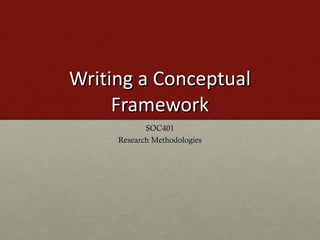Writing a conceptual framework
•Download as PPT, PDF•
241 likes•545,382 views
Report
Share
Report
Share

Recommended
Recommended
More Related Content
What's hot
What's hot (20)
Writing the Theoretical and Conceptual Framework of a Quantitative Research

Writing the Theoretical and Conceptual Framework of a Quantitative Research
Research problem, hypothesis & conceptual framework

Research problem, hypothesis & conceptual framework
Chapter 2. Identifying the inquiry and stating the problem (Practical Researc...

Chapter 2. Identifying the inquiry and stating the problem (Practical Researc...
Viewers also liked
Viewers also liked (20)
The IPO Model of Evaluation (Input-Process-Output)

The IPO Model of Evaluation (Input-Process-Output)
Application of theories, models and conceptual frameworks into family health ...

Application of theories, models and conceptual frameworks into family health ...
K to 12 Curriculum Guide for Edukasyon sa Pagpapakatao 

K to 12 Curriculum Guide for Edukasyon sa Pagpapakatao
Similar to Writing a conceptual framework
Similar to Writing a conceptual framework (20)
Research questions & hypotheses,Qualitative ,Quantitative and mixed methods

Research questions & hypotheses,Qualitative ,Quantitative and mixed methods
Resaerch-design-Presentation-MTTE-1st-sem-2023.pptx

Resaerch-design-Presentation-MTTE-1st-sem-2023.pptx
How to write the methodology chapter of a dissertation or thesis

How to write the methodology chapter of a dissertation or thesis
Framework for Program Development and EvaluationReference.docx

Framework for Program Development and EvaluationReference.docx
Solving research problem_3539ce35db1215c11a780b1712d47e46

Solving research problem_3539ce35db1215c11a780b1712d47e46
chapter1ofaresearchpaper-150708005810-lva1-app6891.pdf

chapter1ofaresearchpaper-150708005810-lva1-app6891.pdf
To prepare for writing the research proposal, identify a topic of 

To prepare for writing the research proposal, identify a topic of
designing proposal for research projects budget and funding schemes

designing proposal for research projects budget and funding schemes
More from wtidwell
More from wtidwell (20)
Recently uploaded
Making communications land - Are they received and understood as intended? webinar
Thursday 2 May 2024
A joint webinar created by the APM Enabling Change and APM People Interest Networks, this is the third of our three part series on Making Communications Land.
presented by
Ian Cribbes, Director, IMC&T Ltd
@cribbesheet
The link to the write up page and resources of this webinar:
https://www.apm.org.uk/news/making-communications-land-are-they-received-and-understood-as-intended-webinar/
Content description:
How do we ensure that what we have communicated was received and understood as we intended and how do we course correct if it has not.Making communications land - Are they received and understood as intended? we...

Making communications land - Are they received and understood as intended? we...Association for Project Management
Mehran University Newsletter is a Quarterly Publication from Public Relations OfficeMehran University Newsletter Vol-X, Issue-I, 2024

Mehran University Newsletter Vol-X, Issue-I, 2024Mehran University of Engineering & Technology, Jamshoro
Recently uploaded (20)
Beyond_Borders_Understanding_Anime_and_Manga_Fandom_A_Comprehensive_Audience_...

Beyond_Borders_Understanding_Anime_and_Manga_Fandom_A_Comprehensive_Audience_...
Making communications land - Are they received and understood as intended? we...

Making communications land - Are they received and understood as intended? we...
Unit 3 Emotional Intelligence and Spiritual Intelligence.pdf

Unit 3 Emotional Intelligence and Spiritual Intelligence.pdf
Food safety_Challenges food safety laboratories_.pdf

Food safety_Challenges food safety laboratories_.pdf
Jual Obat Aborsi Hongkong ( Asli No.1 ) 085657271886 Obat Penggugur Kandungan...

Jual Obat Aborsi Hongkong ( Asli No.1 ) 085657271886 Obat Penggugur Kandungan...
Interdisciplinary_Insights_Data_Collection_Methods.pptx

Interdisciplinary_Insights_Data_Collection_Methods.pptx
Unit-V; Pricing (Pharma Marketing Management).pptx

Unit-V; Pricing (Pharma Marketing Management).pptx
UGC NET Paper 1 Mathematical Reasoning & Aptitude.pdf

UGC NET Paper 1 Mathematical Reasoning & Aptitude.pdf
General Principles of Intellectual Property: Concepts of Intellectual Proper...

General Principles of Intellectual Property: Concepts of Intellectual Proper...
Basic Civil Engineering first year Notes- Chapter 4 Building.pptx

Basic Civil Engineering first year Notes- Chapter 4 Building.pptx
Sensory_Experience_and_Emotional_Resonance_in_Gabriel_Okaras_The_Piano_and_Th...

Sensory_Experience_and_Emotional_Resonance_in_Gabriel_Okaras_The_Piano_and_Th...
Writing a conceptual framework
- 1. Writing a Conceptual Framework SOC401 Research Methodologies
- 3. Conceptual framework It is the researcher ’ s own position on the problem and gives direction to the study. It may be an adaptation of a model used in a previous study, with modifications to suit the inquiry. Aside from showing the direction of the study, through the conceptual framework, the researcher can be able to show the relationships of the different constructs that he wants to investigate.
- 4. Conceptual Framework. News values, and the pressures and constraints shape the newspapers and television newscasts. The result of this relationship is selective reporting of events. Conceptual Framework
- 5. Operational Framework. Foreign news sections of Philippine newspapers and foreign news segments of television newscasts are shaped by the interests of owners, editorial policies, audience and advertisements. The criteria for selection of foreign news, the news values, also affect the foreign news coverage. These factors result in unequal treatment of stories and paved way for the dominance of some topics and of some regions in foreign news coverage of media.
- 13. The Deductive Approach Used in Quantitative Research Researcher measures or observes variables using an instrument to obtain scores Researcher defines and operationalizes variables derived from the theory Researcher tests hypotheses or research questions from the theory Researcher tests or verifies a theory
- 14. Placing Theory in a Quantitative Study Placement Advantages Disadvantages In the introduction Common approach; familiar to readers; conveys a deductive approach Difficult for a reader to isolate theory base from other components of the research process In the literature review Including theories in a literature review is a logical extension or part of the literature Difficult for a reader to see the theory in isolation from the larger literature After hypotheses or research questions The theory discussion explains how and why variables are related May leave out an extended discussion about the origin and use of the theory In a separate section Clearly separates the theory from other components of the research process, enables a reader to better identify and to understand the theory base The theory discussion is isolated and may not easily connect with other components of the research process
- 16. The Inductive Logic of Research in a Qualitative Study Researcher asks open-ended questions of participants or records fieldnotes Researcher analyzes data to form themes or categories Researcher looks for broad patterns, generalizations, or theories from themes or categories Researcher poses generalizations, or theories, and compares to past experiences and literature Researcher gathers information
